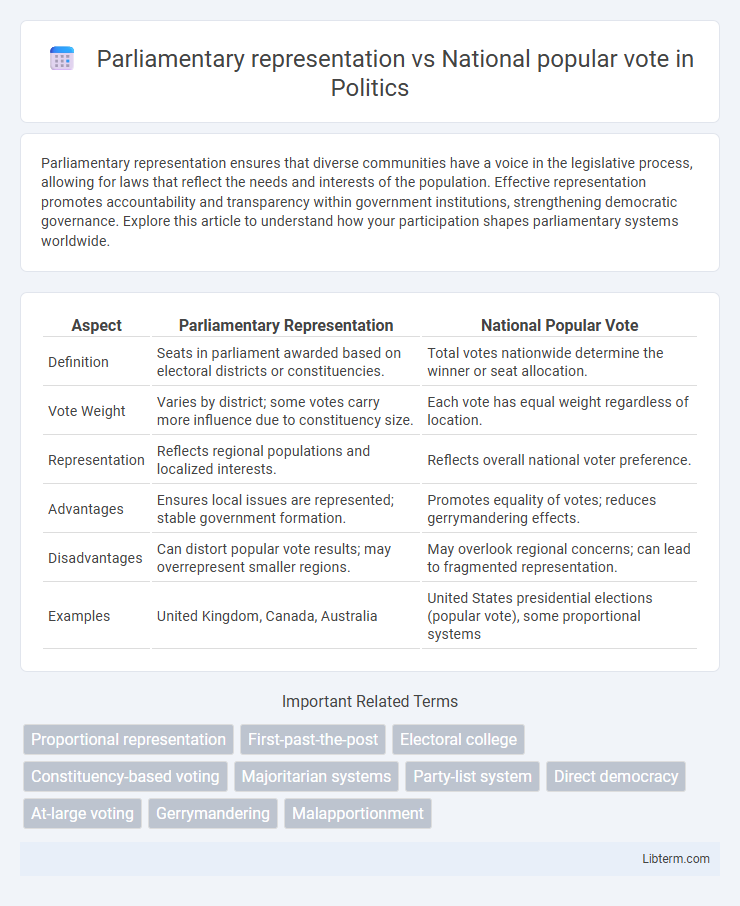Parliamentary representation ensures that diverse communities have a voice in the legislative process, allowing for laws that reflect the needs and interests of the population. Effective representation promotes accountability and transparency within government institutions, strengthening democratic governance. Explore this article to understand how your participation shapes parliamentary systems worldwide.
Table of Comparison
| Aspect | Parliamentary Representation | National Popular Vote |
|---|---|---|
| Definition | Seats in parliament awarded based on electoral districts or constituencies. | Total votes nationwide determine the winner or seat allocation. |
| Vote Weight | Varies by district; some votes carry more influence due to constituency size. | Each vote has equal weight regardless of location. |
| Representation | Reflects regional populations and localized interests. | Reflects overall national voter preference. |
| Advantages | Ensures local issues are represented; stable government formation. | Promotes equality of votes; reduces gerrymandering effects. |
| Disadvantages | Can distort popular vote results; may overrepresent smaller regions. | May overlook regional concerns; can lead to fragmented representation. |
| Examples | United Kingdom, Canada, Australia | United States presidential elections (popular vote), some proportional systems |
Introduction to Parliamentary Representation and National Popular Vote
Parliamentary representation allocates legislative seats based on electoral districts, enabling localized governance and reflecting regional interests within the legislature. National popular vote determines the overall winner by tallying votes from across the entire country, emphasizing the total voter preference regardless of geographic distribution. Understanding these systems highlights the balance between regional representation and direct democracy in electing government officials.
Historical Context of Electoral Systems
Parliamentary representation has its roots in medieval England, where representatives were elected to speak for distinct geographic constituencies, reflecting localized interests within a broader governance framework. The national popular vote emerged as a democratic principle emphasizing the aggregate total of individual votes across a country, gaining prominence with the expansion of universal suffrage in the 19th and 20th centuries. Historical debates over these systems revolve around balancing equitable regional representation with the democratic ideal of one-person, one-vote in modern electoral frameworks.
Defining Parliamentary Representation
Parliamentary representation involves electing officials to legislative bodies based on geographic constituencies, ensuring local interests are directly voiced in government decisions. This system contrasts with the national popular vote, which aggregates votes across the entire country to determine election outcomes without emphasizing individual district representation. Defining parliamentary representation requires understanding its role in promoting accountability and regional balance within a legislative framework.
Understanding the National Popular Vote
The National Popular Vote (NPV) is a reform initiative aimed at ensuring the U.S. president is elected by the total popular vote rather than the Electoral College. This system allocates electors based on the nationwide popular vote, creating a direct correlation between voter preferences and the presidential outcome. Understanding the NPV highlights its potential to enhance democratic representation by addressing disparities in parliamentary representation across states.
Comparative Analysis: Structure and Mechanisms
Parliamentary representation typically relies on geographic constituencies where elected officials represent distinct districts, emphasizing localized interests within a legislative body. In contrast, the national popular vote aggregates individual votes across the entire country, prioritizing the direct expression of voter preference on a broad, countrywide scale. Comparative analysis reveals that parliamentary systems often use first-past-the-post or proportional representation mechanisms, fostering party-based governance, while national popular vote systems emphasize majority rule or runoff methods to determine the winner in presidential or referential elections.
Advantages of Parliamentary Representation
Parliamentary representation ensures that diverse political parties and regional interests have a direct voice in the legislative process, enhancing democratic inclusivity. It fosters accountability as elected officials represent specific constituencies, making it easier for voters to monitor and influence their representatives. This system promotes stable governance by often encouraging coalition-building and consensus among multiple parties.
Strengths of the National Popular Vote System
The national popular vote system ensures that every vote carries equal weight, promoting a more direct and democratic reflection of public will compared to parliamentary representation. It eliminates disparities caused by electoral districts, reducing the impact of gerrymandering and ensuring that candidates focus on broad national appeal. This system fosters greater voter engagement by making every ballot count equally toward the final outcome.
Democratic Implications and Voter Influence
Parliamentary representation often leads to a stronger connection between elected officials and specific geographic constituencies, enhancing localized voter influence and accountability in legislative decision-making. In contrast, the national popular vote emphasizes overall voter preference across the entire country, potentially offering a more direct reflection of the electorate's collective will but diluting regional representation. These contrasting systems impact democratic implications by balancing between majority rule and minority rights, influencing political party strategies, voter engagement, and the perceived legitimacy of election outcomes.
Global Case Studies: Successes and Challenges
Global case studies reveal that parliamentary representation often ensures regional interests are addressed, as seen in Germany's mixed-member proportional system, which balances constituency seats with party lists to enhance proportionality. In contrast, national popular vote systems, exemplified by New Zealand's shift to a mixed-member electoral system, tend to increase voter equality and reduce disproportionality but may face challenges in maintaining clear local accountability. Successes emerge when hybrid models integrate the strengths of both approaches, whereas challenges include managing complexity and ensuring voter understanding across diverse political contexts.
Future Perspectives and Reform Debates
Parliamentary representation and the national popular vote remain central in electoral reform debates with future perspectives focusing on balancing democratic legitimacy and effective governance. Advocates for parliamentary systems emphasize proportional representation to ensure minority voices influence policy decisions, while supporters of national popular vote argue it enhances voter equality and reflects the true popular mandate. Reform proposals increasingly consider hybrid models integrating proportional representation within nationally aggregated vote counts to address representational disparities and strengthen democratic accountability.
Parliamentary representation Infographic

 libterm.com
libterm.com